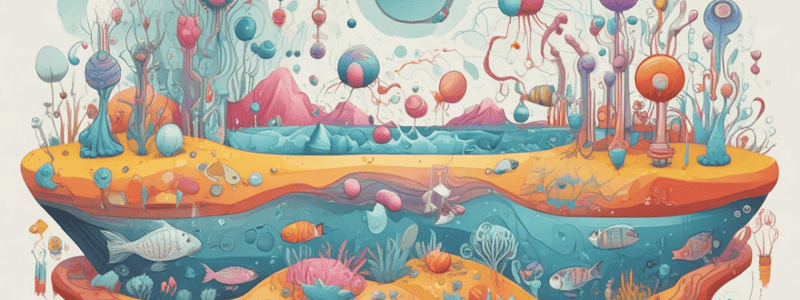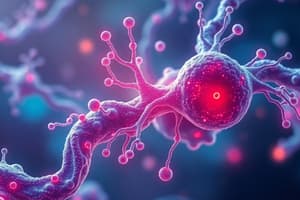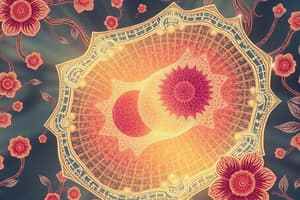Podcast
Questions and Answers
What is the study of interactions between organisms and their environment?
What is the study of interactions between organisms and their environment?
- Ecology (correct)
- Botany
- Cellular biology
- Microbiology
What is the primary function of mitochondria in a cell?
What is the primary function of mitochondria in a cell?
- Genetic information storage
- Protein synthesis
- Generating energy for the cell (correct)
- Regulating what enters and leaves the cell
What is the process by which cells generate energy from glucose?
What is the process by which cells generate energy from glucose?
- Respiration (correct)
- Meiosis
- Photosynthesis
- Mitosis
What is the term for the movement of genes from one population to another?
What is the term for the movement of genes from one population to another?
What is the term for organisms that break down dead organic matter?
What is the term for organisms that break down dead organic matter?
What is the study of microorganisms?
What is the study of microorganisms?
What is the primary function of the endoplasmic reticulum in a cell?
What is the primary function of the endoplasmic reticulum in a cell?
What is the term for the process by which new species emerge?
What is the term for the process by which new species emerge?
Flashcards are hidden until you start studying
Study Notes
Branches of Biology
- Botany: study of plants
- Zoology: study of animals
- Microbiology: study of microorganisms
- Ecology: study of interactions between organisms and their environment
- Evolutionary biology: study of evolution and species diversity
- Molecular biology: study of biological molecules and their interactions
- Cellular biology: study of cell structure, function, and behavior
Biomolecules
- Carbohydrates: energy storage and structural molecules
- Proteins: enzymes, structural molecules, and transport molecules
- Lipids: energy storage and structural molecules
- Nucleic acids: DNA and RNA, genetic information storage
Cell Structure
- Plasma membrane: regulates what enters and leaves the cell
- Cytoplasm: gel-like substance inside the cell membrane
- Nucleus: contains genetic material
- Mitochondria: generates energy for the cell
- Endoplasmic reticulum: involved in protein synthesis and transport
- Ribosomes: site of protein synthesis
- Lysosomes: contain digestive enzymes
Cellular Processes
- Photosynthesis: process by which plants convert light energy into chemical energy
- Respiration: process by which cells generate energy from glucose
- Mitosis: process of cell division that results in two identical daughter cells
- Meiosis: process of cell division that results in four non-identical daughter cells
- Protein synthesis: process by which cells create proteins from amino acids
Evolution
- Speciation: process by which new species emerge
- Natural selection: process by which populations adapt to their environment
- Genetic drift: random change in the frequency of a gene in a population
- Gene flow: movement of genes from one population to another
- Mutation: change in the DNA sequence of an individual
Ecosystems
- Producers: organisms that make their own food (plants, algae)
- Consumers: organisms that obtain energy by consuming other organisms
- Decomposers: organisms that break down dead organic matter
- Food chain: sequence of organisms that eat other organisms
- Food web: network of food chains in an ecosystem
Branches of Biology
- Botany focuses on the study of plants and their structures, functions, and interactions.
- Zoology is concerned with the study of animals, including their evolution, behavior, and physiology.
- Microbiology explores the world of microorganisms, including bacteria, viruses, and other microorganisms.
- Ecology examines the interactions between organisms and their environment, including the impact of environmental factors on ecosystems.
- Evolutionary biology delves into the study of evolution and species diversity, including the processes that shape the diversity of life on Earth.
- Molecular biology investigates the structure, function, and interactions of biological molecules, such as DNA, proteins, and carbohydrates.
- Cellular biology examines the structure, function, and behavior of cells, the basic units of life.
Biomolecules
- Carbohydrates serve as energy storage molecules and structural components of cells, such as cellulose in plant cell walls.
- Proteins perform a wide range of functions, including acting as enzymes, structural molecules, and transport molecules.
- Lipids store energy and provide structural components for cells, such as the phospholipid bilayer of the plasma membrane.
- Nucleic acids, including DNA and RNA, store genetic information and play a central role in the transmission of traits from one generation to the next.
Cell Structure
- The plasma membrane regulates what enters and leaves the cell, controlling the exchange of materials.
- Cytoplasm is a gel-like substance inside the cell membrane, providing a medium for chemical reactions and cellular activities.
- The nucleus contains the genetic material, DNA, which is organized into chromosomes.
- Mitochondria generate energy for the cell through cellular respiration, producing ATP.
- The endoplasmic reticulum is involved in protein synthesis and transport, modifying and packaging proteins for use in the cell.
- Ribosomes are the site of protein synthesis, reading mRNA sequences to assemble amino acids into proteins.
- Lysosomes contain digestive enzymes, breaking down and recycling cellular waste and foreign substances.
Cellular Processes
- Photosynthesis occurs in specialized organelles called chloroplasts, converting light energy into chemical energy through the Calvin cycle.
- Respiration generates energy for the cell through the breakdown of glucose, producing ATP and water.
- Mitosis is the process of cell division that results in two identical daughter cells, each with a complete set of chromosomes.
- Meiosis is the process of cell division that results in four non-identical daughter cells, each with half the number of chromosomes as the parent cell.
- Protein synthesis involves the transcription of DNA into mRNA, followed by the translation of mRNA into a polypeptide chain.
Evolution
- Speciation occurs when a new species emerges, often as a result of geographic isolation or adaptation to a new environment.
- Natural selection acts on the variation present in a population, favoring individuals with traits that enhance survival and reproduction.
- Genetic drift is the random change in the frequency of a gene in a population, often resulting from chance events.
- Gene flow occurs when individuals with different genetic traits move into a population, increasing genetic variation.
- Mutation is a change in the DNA sequence of an individual, which can result in new traits or increased susceptibility to disease.
Ecosystems
- Producers, such as plants and algae, use energy from sunlight to synthesize organic compounds, forming the base of the food web.
- Consumers, including herbivores and carnivores, obtain energy by consuming other organisms, transferring energy through the food web.
- Decomposers, such as bacteria and fungi, break down dead organic matter, releasing nutrients back into the environment.
- Food chains illustrate the sequence of organisms that eat other organisms, with each level representing a trophic level.
- Food webs depict the complex network of food chains in an ecosystem, highlighting the interconnectedness of species.
Studying That Suits You
Use AI to generate personalized quizzes and flashcards to suit your learning preferences.




